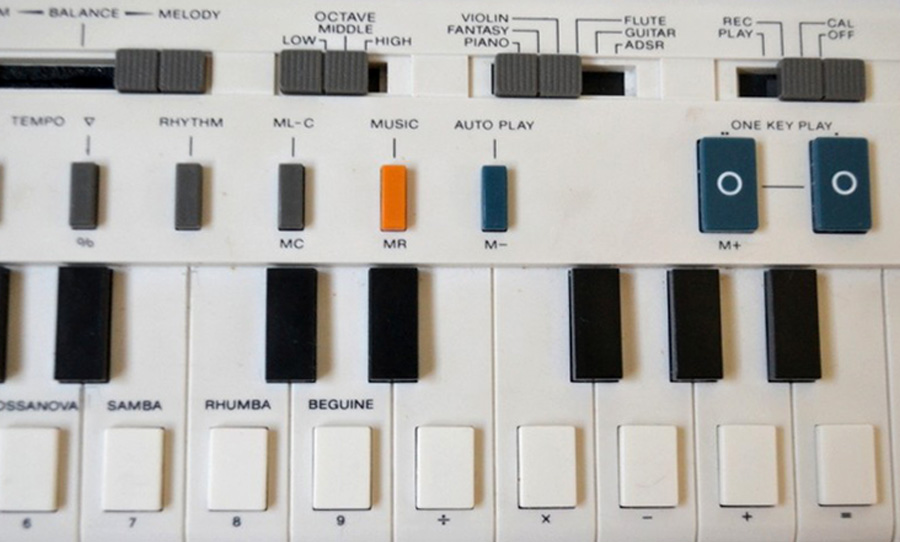We go diving into the Casio VL-1 calculator / keyboard hybrid and how creating with limitations can yield prodigious results.
It’s a Saturday night and you’re in the crowd at the concert of your favourite band. It’s also tax time, and naturally, you’ve decided to multitask and crunch some numbers on your trusty calculator while rocking out.
Suddenly, in the middle of the solo to your favourite song, the guitarist has an aneurism and falls backwards through the stage curtains. The show screeches to a halt and a member of the stage crew advises the heckling crowd that the night is over.
Then it hits you!
You jump over the barricade, creep up to side stage, and just as security attempts to intervene, you run into a majestic knee slide through the guard’s legs and out onto centre stage.
As the now silent crowd stares in awe you pull your calculator out, because this isn’t any old calculator, it’s a Casio VL-1 – calculator / keyboard hybrid.
Switching it to keyboard mode you smash out the end of the solo along with the band and the crowd goes wild. At the end of the show the band signs you on as a permanent member and you live the rest of your life as a rock star.
We’ve all had that dream at least once right? RIGHT? Me neither. That’s because the concept of playing music on a calculator is stupid. Or is it?

But that’s just what the Casio VL-1 was marketed as – a calculator with an inbuilt keyboard function. It should be noted that soon after release, the marketing on the product was reversed and sold as a keyboard with a calculator function, and you’d be pretty wrong if you said the little critter hadn’t had its day in the music world.
There’s a fairly hefty history of well-known acts featuring the signature bleeps and bloops in their music, such as Lady GaGa, Panic! at the Disco, Bloodhound Gang and for a clear example of the VL-1 sound, I recommend having a listen to the hauntingly familiar rhythmic blips in Fergie’s 2007 throwback Clumsy.
The VL-1 is monophonic and sports 29 ‘keys’ which are actually more like buttons, with the ability to shift up or down an octave. There are five preset sounds that are cheesier than a wheel of Gruyère, and a sixth voice option that may actually surprise you.
The sixth setting allows you to delve into the synth’s sound design features by changing the values that make up the sound, which includes waveform, ADSR, vibrato and tremolo. This was actually pretty nifty for the time, and being Casio’s first keyboard with onboard memory, you could save the setting as the sixth preset for future use.
The keyboard also has a rhythm section with 10 percussive patterns equally as cheesy as the tones, and a sequencer that allows you to save a series of notes and play them back one by one in your own rhythm using the ONE KEY PLAY button.
Casio continued its affordable keyboard legacy through the 80s with the Casiotone series, while its competitor Yamaha introduced the PortaSound, a line of small portable keyboards with similar cheap and quirky sounds. Between the time of the VL-1’s release and now, the world has seen a plethora of keyboards released by countless manufacturers designed to be affordable for the average Joe, resulting in equally as kitsch qualities.
But the thing is, sometimes being kitsch is cool. If you’re ever listening to Gorillaz, make a point of listening to the percussion and you’ll notice that a whole bunch of their music (most of Plastic Beach for instance) features preset drum rhythms from these old keyboards. Or if you’re a Hot Chip fan, the majority of their second album The Warning were recorded using the similarly toy-like Casio MT-70 as the source.
The tongue-in-cheek sounds compliment certain styles of film too, like John Swihart’s soundtrack for Napolean Dynamite. And if you still can’t find the right spot in your mix, just run them through a bunch of effects pedals like an overdrive or an octaver and BAM! You’ve got something completely different.
The best thing about all of these ‘amateur’ keyboards is that they’re dirt cheap, and you can find loads of them in garage sales or certain op shops, poking out behind the fur coat that smells like someone managed to die in it twice.
If you haven’t already, I urge you to buy the next wacky little keyboard you see and attempt to write a whole track – nay, A WHOLE ALBUM – using only the sounds from the keyboard and whatever tools you can manage to run it through. Creating within limitation is awesome, and you’ll most likely take a thing or two from it to your next masterpiece.
Sure, the Casio VL-1 is a glorified calculator, but bringing music into the world through mundane objects makes life a little lighter to deal with, right?
Think back to when you were playing your uncle’s bald head like a bongo mid piggyback, or blowing sweet little ditties on one of those whistle lollipops while your mother gazed chin in hand out the kitchen window fantasising about you accidentally inhaling it.
The point is, music may have to be meaningful to be serious, but it doesn’t have to be serious to be meaningful.



